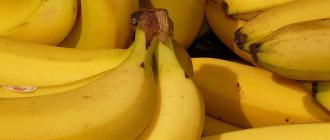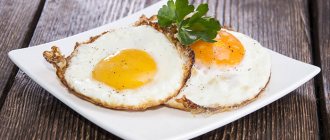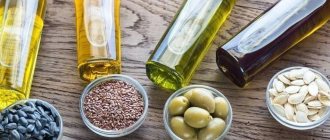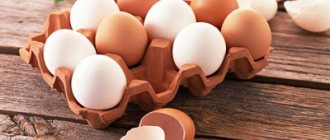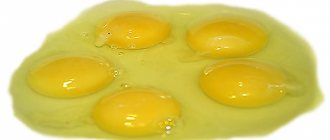Calorie content and nutritional value of a hard-boiled egg
The number of calories in one chicken egg depends on its size. An average egg weighs about 60 grams and contains 65-80 calories.
The yolk is considered the most high-calorie part; the white contains virtually no calories and is widely used in dietary nutrition. However, the use of protein plays a big role in saturating the body with essential elements.
The composition of the egg contains the following BJU indicators:
- Protein -6.6g
- Fat – 6.1g
- Carbohydrates -0.3 g.
Good to know! Despite the low carbohydrate content, this product is used in dietary nutrition and can fully replace a ready-made dish.
Calorie content of boiled egg white and yolk
A chicken egg has three components: white, yolk, and eggshell. Egg whites are a low-calorie food, with one medium egg containing 15 to 20 calories. However, this indicator is quite sufficient to obtain the required norm of nutrients.
The caloric properties of chicken yolk have up to 40 calories, this figure depends on the size of the egg.
It should be noted! That different processing of the product has different caloric properties and BJU content.
Calorie content by type of preparation
Chicken eggs have a large number of processing methods, which in turn have different degrees of calorie content.
The raw product contains:
- 120 calories
- Fats - 8 g
- Proteins-11 g
- Carbohydrates -0.7g
A boiled egg contains:
- 80 calories
- Proteins-6.6g
- Fats -6.1
- Carbohydrates -0.3g
A soft-boiled egg contains:
- 65 calories
- Proteins -6 g
- Fats -5.8
- Carbohydrates -0.3
Processed by frying in oil, contains:
- 120 calories
- Proteins -12g
- Carbohydrates -0.7
- Fats-9 g.
The lowest-calorie product is soft-boiled.
Beneficial features
The benefits of daily consumption are very great:
- Improve metabolism;
- Relieve tension and stress;
- Increase visual acuity;
- Saturate the body with essential amino acids;
- Strengthen bone tissue;
- Prevents the development of cancer;
- Normalizes liver function;
- Improves memory;
- Positively affects blood circulation;
- Strengthens the cardiovascular system.
We told you how much protein is contained in one egg - add the product to your diet without fear, eat it for breakfast and lunch. As long as you stay within your daily allowance, you can get exceptional benefits from every bite!
The benefits and harms of boiled eggs for weight loss
A chicken egg contains a large amount of useful substances. The protein that the product contains is the most digestible and contains a large number of useful elements.
The substances that egg whites contain help restore immunity after various diseases, and are also required for the development process, especially for children.
The yolk contains microelements such as:
- Vitamins of groups A, B, E
- Calcium
- Iron
- Phosphorus
- Kholin
- Lecithin
For those who want to lose extra pounds, consuming this product can reduce calories consumed and satisfy the feeling of hunger.
Nutritionists recommend consuming boiled eggs during the weight loss procedure to saturate the body with useful substances, and consuming the product for breakfast allows you to get the necessary energy, while the number of calories consumed remains low.
However, in addition to beneficial properties, the product has some harmful ones. It should be noted that the consumption of the product should be reduced to the following categories of people:
- If you have protein intolerance
- For allergic reactions to yolk
- People who have high cholesterol levels
- Presence of diabetes mellitus
- Previous heart attacks and strokes.
Let's celebrate! It is also necessary to take into account the fact that consuming large quantities of the product also has a negative impact on a person’s well-being, especially when following a diet. People suffering from obesity should be very careful when consuming egg yolks, as constipation may worsen.
Daily consumption rate
In order for the product to be beneficial, experts recommend eating no more than 4 pieces per day. If this indicator is exceeded, a person is at risk of increasing cholesterol levels.
For those who want to lose weight, the permissible norm per day is no more than 2 pieces. For people suffering from diabetes mellitus, the permissible norm of the product is no more than one per week.
Note! Dietary nutrition experts note that it is advisable to consume the product in hard-boiled or soft-boiled form. Eating raw food of this type is practically not absorbed by the body and can lead to the presence of a dangerous stomach disease.
How many grams of protein are in one egg
Any egg consists of three components:
- protein - is a liquid, transparent, slightly viscous mass surrounding the yolk;
- yolk - a liquid mass inside a white shell, when heated, it curls into a powdery ball;
- shell - a hard shell that covers both components.
Experts advise consuming only the white part to build muscle or lose weight, and it is better to avoid the inner yellow part, since it contains a lot of cholesterol. For proper nutrition, you need to know exactly how much protein is contained in a chicken egg.
1 standard size chicken egg contains approximately 6-7 grams of the substance in question. Its quantity is directly related to the size of the product. A small one may contain about 5 grams, and a large one - a little more than 8. A man needs 56 g of the substance per day, and a woman needs 46 g - this amount is enough for the normal functioning of all body systems.
It is also recommended to study exactly how much protein is in the product as a whole and in its constituent parts? The yolk contains many useful elements and fat. It also contains protein, and its amount is almost half of the total content in one piece. If you take a large egg, it contains only 7 grams of protein: 3 of them are in the yolk, and 4 are in the white part. Therefore, you need to eat whole chicken products - this will increase the standard of the main substance and replenish the body with additional useful microelements.
How to choose and store eggs correctly?
In order to choose the right quality product, you should pay attention to some factors, such as:
- Shell integrity
- The shell must be clean without traces of dirt
- The shell must have a uniform surface without deformation
Good to know! According to all standards, when purchasing products at retail outlets, there must be a special marking that indicates to the buyer the shelf life and what category the product belongs to.
The degree of freshness of the product is of great importance; this indicator can be determined in several ways:
- The shell of a fresh product should not be glossy; a fresh egg has a matte surface.
- There should be no sounds during shaking.
- A product that is not fresh tends to float in salt water.
- When split, the protein should not contain additional impurities and be absolutely transparent in color.
- When cleaning a cooked product, removing the shell from a fresh product will be problematic.
Egg whites and yolks are components of many common dishes, so almost every home has a decent supply of this kind of product. Also, this product differs from many other types of food in its long shelf life.
Note! This product can be stored for up to three weeks in the refrigerator and two weeks at room temperature. The prepared product can be stored in the refrigerator for up to two weeks, while all the beneficial substances will be preserved in full.
For proper storage, some rules should be taken into account:
- Storage should be done in the refrigerator in a specially designated place, where the temperature is several degrees higher.
- The product must be placed with the pointed parts facing down.
- It is unacceptable to wash the surface of the shell, this will reduce the shelf life
- Great attention should be paid to the expiration date, which is indicated on special labeling.
If the shell is cracked, be sure to wipe the remaining eggs with a clean cloth to avoid the appearance of an unpleasant odor.
Product types and categories
Before you figure out how much protein is in an egg, you need to understand what types of product exist. Often people take packaging without thinking about the subtleties - caring only about integrity. We will go further and figure out what types and categories are currently on store shelves.
Let's start with the view - there are only two of them.
- Dietary (D). The shelf life does not exceed seven days; there is a corresponding red stamp on the shell. The shell is clean, with a small number of dots, the amount of space occupied by air under the shell does not exceed 4 mm;
- Dining rooms (C). There is a blue stamp on the shell with the corresponding letter, the amount of empty space is from 5 to 7 mm. The shelf life reaches 25 days outside the refrigeration chamber and 90 days inside it; there may be dots and stripes on the shell (but not more than 12.5% of the total surface area).
The only difference between them is the shelf life; these are not specific varieties or different products. Most often on the shelves we find a product labeled “C”. Therefore, it’s worth talking separately about possible categories! There are several of them, now you will find out all the necessary information, and then we will talk about how many grams of protein are in one egg.
We also recommend: Fennel and dill: what's the difference
Product category is determined by weight! Now you will find out how much protein is in an egg C0 and others:
| Category | Size | Approximate weight (in grams) | Amount of protein (in grams) |
| C3 | Little ones | 40 | 4,4 – 5,7 |
| C2 | Average | 50 | 5,7 – 7,0 |
| C1 | Large | 60 | 7,0 – 8,2 |
| C0 (Selected) | Very big | 70 | 8,2 – 9,5 |
| SV (Higher) | Huge | 75 | 9,5 – 12,7 |
Separately, you can isolate the protein in the yolk of an egg - approximately 2.5 - 3 grams! The rest of the element is contained in the protein shell.
Methods for boiling eggs
Egg whites and yolks are used to prepare various types of salads and many other equally tasty and healthy dishes.
However, there are several most common cooking methods:
- Hard-boiled - place in cold water, bring to a boil, and simmer over low heat for 10 minutes.
- Soft-boiled – place in cold water, bring to a boil and cook for 3 minutes
- Soft-boiled with solid protein - place in cold water, bring to a boil and simmer for 4 minutes.
- Cooked “in a bag” - cooking time is 5 minutes after boiling water
- Boiled without shells - dissolve one teaspoon of salt and 50 mil vinegar in one liter of water, bring to a boil and carefully beat in the egg without damaging the yolk. Cook for seven minutes over low heat.
To make the finished product easier to peel, after cooking it is necessary to place it in cold water for a few minutes.
Good to know! Using eggs allows you to prepare a huge selection of different dishes, and is also an indispensable product for weight loss. However, you should know that before preparing food, you need to check the quality of the products. Spoiled chicken eggs tend to cause poisoning and other stomach diseases.
What is the benefit of the product
The chicken product is considered dietary and is included in the diet when recovering from serious illnesses and during weight loss. At the same time, most people wonder how many calories are in an egg if it helps with weight loss? There are few calories in it - one boiled unit is only 77 units.
But eggs contain many useful elements that are necessary for people on a diet. For example, choline, without which a person will have problems with the heart and brain function.
When losing weight, they are simply a godsend, because they allow you to keep your stomach full for a long time. This effect is especially visible if consumed for breakfast. Experts have noticed that if you eat a protein breakfast, your calorie intake decreases throughout the day. Microelements and substances are quickly and completely absorbed. This applies to the cooked version of the product, but not the raw version. One protein contains 13% protein, no more than 2% fat and carbohydrates, the rest is water. All components contain a rich composition of vitamins, the list of which includes B, E, D, A, as well as many minerals and enzymes.



